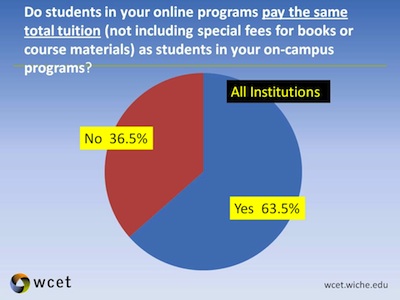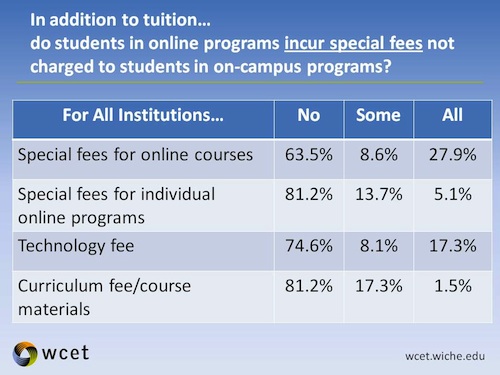 JD Hancock/flickr
JD Hancock/flickr
As the price of attending college increases, questions arise. In the past year, Inside Higher Ed, the Chronicle of Higher Education, and a CNBC guest blog suggested that technologies could cut costs and, presumably, the price of college attendance. The two ex-Stanford professors’ creating free, massively-open courses has also raised additional questions about the economics of online education. The biggest one always being, “Do online students pay more for their education?” The answer appears to be “Often, yes.”
Do Students Pay More for Online College Courses?
The Managing Online Education Survey sheds light on what online students pay. My organization, the Western Cooperative for Educational Telecommunications (WCET), recently conducted the study in partnership with the Campus Computing Project. Institutions from throughout the U.S. answered the following questions, a total sampling of 199 respondents. One of our most significant findings: While most institutions charge online students the same tuition, nearly a third of the respondents – 29 percent – report charging up to $250 or more for online tuition. Others report adding service fees to the bills of online learners. Here’s what they reported: Q: Do students in your online program pay the same tuition for one term? Slightly more than one-third of the survey respondents (see Figure 1) reported charging a tuition that differs from the amount charged to on-campus students.

For the 72 institutions that did not charge the same amount, we asked how much more or less they charged:
- Over $250 less: 9.6%
- $101-$250 less: 4.8%
- $0 – $100 less: 4.8%
- $0 – $100 more: 33.7%
- $101-$250 more: 25.3%
- Over $250 more: 21.7%
This is quite a range of responses. It is interesting to note that a few institutions charge significantly more or less than on-campus rates. Q: Do students in your online program incur special fees not charged to on-campus programs? While the majority of institutions charge the same tuition, some add extra fees. We asked about a variety of fees (see Figure 2) that could be charged by an institution.

A “Some” response covers institutions where a fee might be charged in some of the college’s programs, but not all.
For each type of fee, about twenty to forty percent of institutions charge that fee. For future research, I would like to combine the data on both the tuition and fee questions to obtain the total number of institutions that charge more, regardless of what label they give it.
Should Students Pay More for Online College Courses?
Perhaps, but it should not be a given. This is too complicated a discussion for the space allowed, but I’ll try to summarize. For those who suggest that online courses should cost less because technology is involved, they are not looking at the whole picture. Our research shows that the main cost of technology-mediated education is the people (faculty, designers, support staff) involved. Unless you change how you engage the people, the costs can only go up because you are adding the additional costs of technology, faculty support, and other factors to the traditional classroom model. For those who suggest that online courses can never cost less because technology is involved, they are often mired in replicating the traditional classroom model.
Reshaping The Cost of Online Education
There are examples of courses that have dramatically rethought the classroom model, including: the Open University of the United Kingdom, Rio Salado College and the National Center for Academic Transformation. Happily, I think that these examples also addressed maintaining the quality of academic outcomes. Unfortunately, cost does not always directly relate to the price a student pays. Many other factors play into setting tuition and fees. Additionally, these factors vary widely by program and enrollment size of the course. In my experience, the only time when costs and price are lowered is when those reductions are an explicit goal. It can be done. If collegiate leadership or policy-makers want lower costs and price, they should set goals that a specific program cost less, have a lower price, and maintain quality. Give the academics and online education leadership flexibility in finding ways to meet those goals.
About the Author: Russell Poulin is deputy director, research and analysis, for the WICHE Cooperative for Educational Telecommunications. Based in Boulder, CO, WCET accelerates the adoption of effective practices and policies, advancing excellence in technology-enhanced teaching and learning in higher education. Russ also works on projects, such as: directing the Transparency by Design project and its CollegeChoicesforAdults.org website; directing WCET’s work on the management, financing, and services of elearning consortia; and coordinating with the Campus Computing Project on the Managing Online Education survey. Previously, Russ coordinated distance education activities for the North Dakota University System. He holds a Bachelor’s degree in Mathematics and Economics and a Master’s in Statistics and Research Methodology.
